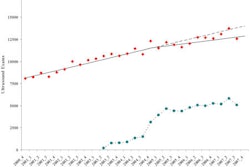
The U.S. Senate last week offered a look at its thinking on a number of proposals to make the U.S. healthcare system more efficient, including several ideas that affect medical imaging. But the Senate isn't giving healthcare professionals much time to mull over the proposals -- the deadline for comment is May 15.
The U.S. government has been weighing a number of options in its quest to reduce costs and improve quality in healthcare programs run by the Centers for Medicare and Medicaid Services (CMS). To that end, the Senate Finance Committee last week issued the first of three sets of recommendations for healthcare policy reform that could ultimately result in specific legislation.
Titled "Proposals to Improve Patient Care and Reduce Health Care Costs," the recommendations include several ideas that have been floated in recent months regarding imaging services, including increased disclosure of physician self-referral arrangements, developing a national accreditation program, and creating a nationwide imaging exchange network to reduce overuse of imaging services.
Self-referral disclosure
The first proposal would try to shed more light on physician self-referral arrangements for imaging procedures through an amendment to the Stark law. The Senate report notes that although Stark prohibits physicians from referring patients to entities in which they have a financial interest, there is an exemption for services provided in physician offices -- an exemption that many critics believe has led to overutilization as nonradiologist physicians buy scanners for their own offices.
Under the Senate proposal, physicians who provide imaging services, including CT, MRI, and PET, would be required to inform patients in writing at the time of referral that the diagnostic imaging procedures being ordered could be obtained elsewhere, and to provide a list of these providers located in the geographic vicinity. If approved, this proposal would become effective January 1, 2010.
Appropriateness criteria for procedures
The second proposal focuses on implementing provisions of the Medicare Improvements for Patients and Providers Act (MIPPA) of 2008, which states that as of January 1, 2012, the federal government will only pay for the technical component of imaging services if the provider is accredited by an accreditation organization.
The report proposes a stepwise implementation of national accreditation. It calls for the U.S. Department of Health and Human Services (HHS) to work with national standards organizations, medical societies, and other bodies to establish nationally recognized appropriateness criteria that would go into effect in 2010. HHS would also set up a mechanism for determining how imaging providers are adhering to appropriateness criteria.
In 2011, HHS would develop a confidential feedback program on patterns of adherence to imaging appropriateness through standardized reporting, with a priority on advanced diagnostic imaging services. The program would focus on baseline rates of adherence and goals for patterns of adherence to appropriateness criteria for imaging exams.
Confidential comparison reports of adherence to appropriateness criteria would be aggregated by the ordering physician and the interpreting practices. HHS would designate the imaging procedures for which mandatory and voluntary reporting would be established.
By 2013, HHS would ratchet up its oversight of the program by varying payment to physicians based on their ability to adhere to the appropriateness criteria for advanced imaging. Differential payments to physicians would be established, including a lower payment for physicians who have been identified as having a history of ordering inappropriate exams.
A 5% reduction in authorized payments, applicable to all medical services provided, would be made for ordering physicians who exceed a threshold for inappropriate ordering patterns, using 2011 data to identify these doctors or practices.
Diagnostic Imaging Exchange Network
In the report's third major proposal, HHS would establish a Diagnostic Imaging Exchange Network in five regions of the U.S. beginning in 2011. Its purpose would be to assist physicians in determining the necessity, safety, and appropriateness of ordering an imaging study, with the intent of minimizing unnecessary, inappropriate, or duplicative radiology procedures.
Utilizing the Nationwide Health Information Network (NHIN) infrastructure and existing healthcare IT standards, the imaging exchange network would equip physicians and providers with HIT-enabled systems to access a patient's entire imaging history prior to ordering an imaging study.
The report's section on imaging concludes by stating that the Finance Committee is also exploring other options for reining in imaging costs and improving quality, such as the use of radiology benefits managers for some imaging services.
Online comments on the recommendations should be submitted on or before May 15 to [email protected].
By Cynthia E. Keen
AuntMinnie.com staff writer
May 6, 2009
Related Reading
Breast imagers get savvy as healthcare reform looms, April 29, 2009
Senate holds healthcare reform meeting, April 23, 2009
Medical imaging hopes to cut losses in Medicare reform debate, January 27, 2009
Copyright © 2009 AuntMinnie.com



















